One of the most interesting behaviors that ducks exhibit is their tendency to bob their heads up and down.
This behavior is often seen in both male and female ducks, but why do they bob their heads?
Ducks bob their heads up and down as part of their communication and courtship rituals. This behavior is often seen in both males and females during mating season. The head-bobbing can signal interest and readiness to mate to potential partners. Ducks may also bob their heads to establish dominance and territory, or as a sign of alertness when they sense danger.
Key takeaways
Ducks bob their heads as an indication of happiness, flirting, or preparation for mating season. It is generally a positive duck behavior that suggests the duck is content and ready to reproduce and normal mating behavior.
Stress in ducks can be identified through signs such as lethargy, reduced egg production, resting more than usual, and ruffled feathers. Any unusual behavior should be addressed promptly to prevent distress or illness.
Indications of a happy duck include frequent quacking and head bobbing. A joyous duck may bob its head for an extended period, indicating a positive state of being.
Ducks may also thrust their heads forward, generally to impress a female or establish dominance. However, this can also be an aggressive move, depending on the target of the action.
There are numerous other duck behaviors to be aware of, including sideways bobs as a reprimand or warning, bubble blowing to clear the nostrils, head tilting indicating curiosity, and tail wagging showing pleasure or enjoyment.
Every duck has its unique tendencies, and understanding these behaviors helps in better care and communication with the flock.
Duck Head Bobbing Behavior
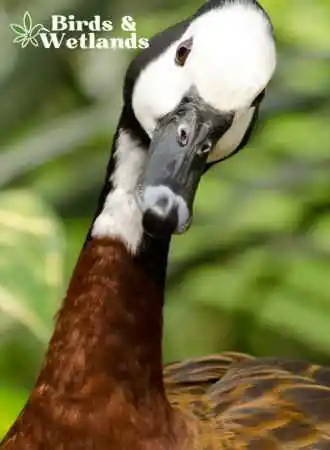
Head bobbing is a common behavior among birds, including ducks. It involves a rhythmic up and down movement of the head, which can vary in speed and intensity. Ducks may also bob their head from side to side, which can indicate aggression or warning. Head bobbing is a form of body language that ducks use to communicate with each other.
Frequency of Ducks Bobbing
Duck head bobbing can occur at any time, but it is most commonly observed during feeding, mating, and social interactions. Ducks may bob their head rapidly or slowly, depending on the situation. The frequency of head bobbing and other male duck behaviors can also vary among different species of ducks.
There are several reasons why ducks bob their head up and down. One reason is to maintain visual stability while walking. The motion allows their eyes to remain level with the horizon, enabling them to have a clear and steady view of their surroundings even while in motion. Ducks may also bob their head to show excitement or anticipation, such as when they are eagerly anticipating food or attention.
Another reason for head bobbing is to communicate with other ducks. Male ducks may bob their head up and down to show they are ready to mate, while females may bob their head to signal their interest. Head bobbing can also be a form of greeting or a way to establish dominance among ducks, specially if there are multiple male ducks in the flock.
Courtship and Mating Behavior
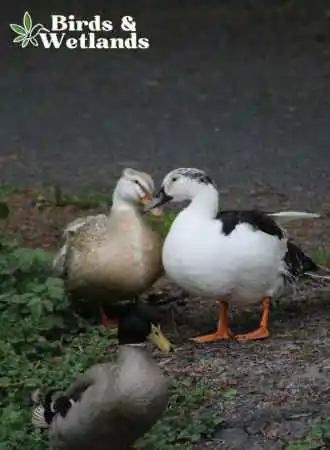
Ducks are known for their unique courtship and mating behavior, which involves a variety of displays and vocalizations. Understanding these behaviors can help us better appreciate these fascinating birds.
Head Bobbing as a Courtship Behavior
One of the most common courtship behaviors in ducks is head bobbing. Both male and female ducks engage in this behavior, which involves rhythmic up-and-down movements of the head. This behavior is often accompanied by sideways bobs and head tilting.
Head bobbing is a way for ducks to signal their courtship intentions to potential mates. It can also be a way for ducks to establish dominance over other ducks in the area. In some cases, head bobbing may simply be a way for ducks to relieve stress or express curiosity.
Head Bobbing as a Mating Behavior
Head bobbing is also an important part of duck mating behavior. During the breeding season, male ducks will bob their heads up and down while emitting a low-pitched quacking sound. This behavior is intended to attract females and indicate their readiness to mate.
Female ducks may also engage in head bobbing as a way to signal their willingness to mate. In some cases, head bobbing may be accompanied by preening, tail wagging, or vocalizations.
Other Courtship and Mating Behaviors
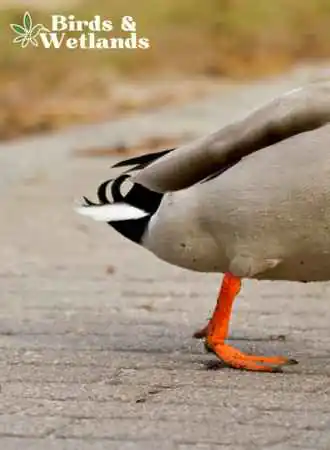
Ducks engage in a variety of other courtship and mating behaviors. These behaviors can include wing flapping, tail wagging, vocalizations, and displays of plumage.
During courtship, male ducks may also engage in aggressive behaviors, such as chasing and biting other ducks in the area. These behaviors are intended to establish dominance and attract potential mates.
Duck courtship and mating behavior is a complex and fascinating subject. By observing these behaviors in the wild, we can gain a deeper appreciation for these remarkable birds.
Duck Communication
Ducks are social animals that use various forms of communication to interact with each other. They use a combination of vocalizations, body language, and physical contact to convey their messages. Understanding these forms of communication can help you better understand your ducks and their needs.
| Duck Behavior | Meaning |
|---|---|
| Quacking | Ducks quack for a variety of reasons including to express happiness, to call their ducklings, or to signal danger. |
| Head Bobbing | Ducks may bob their heads up and down because they’re happy, to greet another duck, or as a mating signal. When they bob their heads left to right it means that they’re angry, or as a warning sign for other ducks to keep distance. |
| Excited Quacking and Head Bobbing | This indicates extreme happiness in ducks. |
| Sideways Head Bobbing | This is usually an indication of anger or warning from the duck, usually performed by senior members of the family, often females. |
| Blowing Bubbles in the Water | This is part of their normal grooming process to expel dirt from their nostrils. |
| Head Tilting | Ducks tilt their heads to better see their surroundings due to fixed eye placement. |
| Walking or Swimming in A Line | This is a safety behavior due to their eye placement. The leading duck focuses on the direction while the rest scan for danger. |
| Sleeping with One Eye Open | Ducks do this to keep watch for danger while they rest. |
| Tail Wagging | This is an indication of pleasure and enjoyment in ducks, often when they get out of the water or receive a treat. |
| Digging Holes in Puddles | This is a foraging behavior for food as insects tend to move towards air after rain. |
| Courtship Behavior | Males exhibit behavior such as bringing treats, flicking water, and nipping to flirt with females they have a bond with. |
| Mating Behavior | Ducks mate mostly in water, and the process can look aggressive, but is normal. |
| Preening After Swimming | This behavior helps ducks spread the oil from their preening gland that makes their feathers waterproof. |
| Excessive Preening | This could indicate a problem with mites or a skin reaction. |
| Shunning | This is a sign of territorial issue or health issue, where a duck is chased away by the others. |
| Imprinting Behavior | Baby ducks imprint on the first thing they interact with repeatedly, usually their mother, but it can be the duck owner if raised in an incubator. |
| Tail Down | This is an emergency sign of an egg stuck in the oviduct, the duck will need immediate help. |
| Aggression | Ducks show aggression by sticking out their necks and running at the one they’re mad at, usually related to territorial or mating issues. |
| Running Away or Shying Away from Contact | This could indicate fear or uncertainty, possibly due to unfamiliar human interaction or changes in the environment. |
| Guarding or Not Leaving the Nest | This is common during the breeding season as female ducks respond to their nesting instinct. |
Other Sounds and Vocalizations
Ducks are known for their distinctive quack, which is a high-pitched sound that they use to communicate with each other. However, ducks also make other sounds and vocalizations, such as grunts, hisses, and purrs. These sounds can convey different messages, such as affection, threat, or stress.
One interesting vocalization that ducks make is a whistle, which is a high-pitched sound that they use to communicate with their mates. Male ducks often use whistles to attract females and establish their dominance.
Body Language
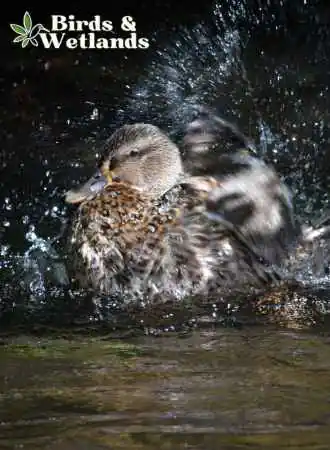
Ducks also use body language to communicate with each other. They use various physical movements and gestures to convey their messages. For example, ducks may use their webbed feet to splash water or blow bubbles to show their excitement. They may also use their nostrils to communicate their mood, such as when they are stressed or unhappy.
Ducks are monogamous animals that form strong bonds with their mates and offspring. They use various forms of physical contact, such as grooming and feeding, to reinforce these bonds. They also use body language to show affection and establish dominance within their social hierarchy.
One interesting behavior that ducks exhibit is head bobbing, which is a rapid movement of the head up and down. Ducks may bob their heads for various reasons, such as to show happiness or as a mating signal. Some ducks may also exhibit sideways head bobbing, which is a warning sign that they are unhappy or in danger.
FAQ
Q: Do ducks sleep with one eye open?
A: Yes, ducks can sleep with one eye open. This is because they have a special adaptation that allows them to shut down one half of their brain while the other half remains alert to potential threats.
Q: Can you incubate duck eggs with chicken eggs?
A: Yes, you can incubate duck eggs with chicken eggs. However, it is important to note that ducks have a longer incubation period than chickens, so you may need to adjust the temperature and humidity levels accordingly.
Overall, understanding duck communication can help you better care for your ducks and strengthen your bond with them. By paying attention to their vocalizations, body language, and physical contact, you can better understand their needs and provide them with a happy and healthy environment.
FAQs about Ducks
What is the Purpose of Duck Head Bobbing?
Duck head bobbing is a common behavior that can be observed in ducks. It is a rapid manner of moving their head up and down, which is often associated with their walking or swimming movements. The purpose of duck head bobbing is to help them maintain their visual stability while moving. As the duck walks or swims, its head moves up and down in sync with its body, allowing the eyes to stay level with the horizon. This helps the duck maintain a clear and steady view of its surroundings, even while moving.
Do All Ducks Bob Their Heads?
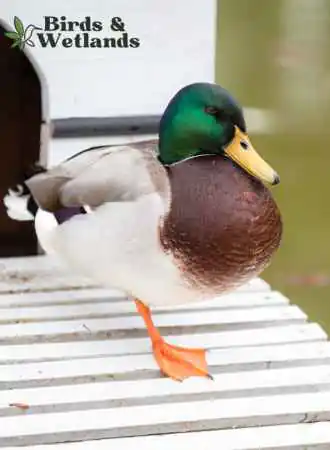
Not all ducks bob their heads. However, it is a common behavior that can be observed in many duck species. Some ducks may bob their heads more frequently than others, depending on their behavioral patterns and the environment they are in. For example, male ducks may bob their heads more often during the breeding season to attract a mate.
What Does It Mean When a Duck Bobs Its Head?
Duck head bobbing can have different meanings depending on the context. For example, if a male duck bobs its head up and down towards a female duck, it’s to flirt. They are either trying to get the attention of the duck or preparing for the mating process. If a male duck is by himself and bobbing up and down, the action is likely out of happiness. Broody females will also bob their heads as a sign of dominance, telling other females to stay away from her nest.
Do Ducks Sleep with One Eye Open?
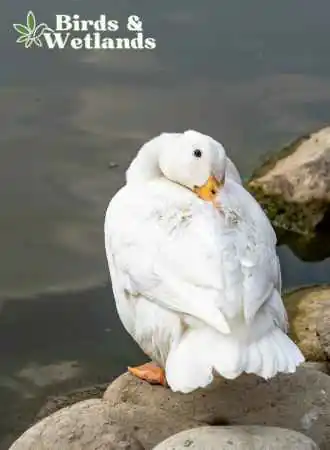
Ducks do not sleep with one eye open. However, they have a unique ability to sleep with one half of their brain at a time, which allows them to stay alert to potential dangers while still getting the rest they need. This is known as unihemispheric slow-wave sleep. Ducks also have webbed feet, which help them swim and move through the water with ease.
Ducklings have a unique behavior called imprinting, where they form a strong bond with the first moving object they see after hatching. This is usually their mother, but it can also be a human or an incubator. Overall, duck head bobbing is a fascinating behavior that can tell us a lot about these unique and interesting birds.

